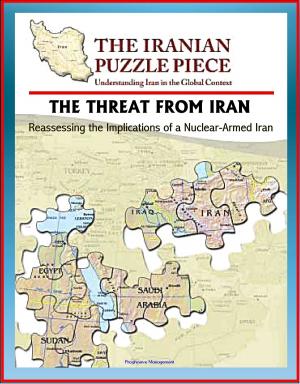Armies in Homeland Security: American and European Perspectives - Terrorism, UK Armed Forces, Germany's Military, NATO, Ukrainian, Romania, France, Hungary, Italy, Austria, Bulgaria, Soviet Legacy, EU
Nonfiction, History, Military, Strategy, Social & Cultural Studies, Political Science| Author: | Progressive Management | ISBN: | 9781310710209 |
| Publisher: | Progressive Management | Publication: | February 15, 2016 |
| Imprint: | Smashwords Edition | Language: | English |
| Author: | Progressive Management |
| ISBN: | 9781310710209 |
| Publisher: | Progressive Management |
| Publication: | February 15, 2016 |
| Imprint: | Smashwords Edition |
| Language: | English |
Professionally converted for accurate flowing-text e-book format reproduction, this book looks at how a number of states are meeting the challenges of homeland security. The authors examine how Austria, Bulgaria, the European Union, France, Germany, Hungary, Italy, Romania, Ukraine, the United Kingdom, and the United States have approached the issue of the employment of military forces in domestic security. This collection of essays offers readers the opportunity to compare and contrast these experiences and the lessons they offer for future contingencies involving the employment of military force in support of civil authorities.
Chapter 1 - Homeland Security and Homeland Defense: America's New Paradigm * Chapter 2 - The Role of the Armed Forces of the United Kingdom in Securing the State against Terrorism * Chapter 3 - The Weight of History: Germany's Military and Domestic Security * Chapter 4 - A New NATO Member's Perspective: Hungary's Army and Homeland Security * Chapter 5 - The Role of Italy's Military in Supporting the Civil Authorities * Chapter 6 - A Neutrals Perspective: The Role of the Austrian Armed Forces in Homeland Security * Chapter 7 - The Soviet Legacy: Transforming Bulgaria's Armed Forces for Homeland Security Missions * Chapter 8 - The Role of the Ukrainian Armed Forces in Homeland Security * Chapter 9 - Armies in Homeland Security: Romania's Experience and Practice * Chapter 10 - The Military's Role in Homeland Security in France * Chapter 11 - The Fruit of EU Homeland Security: Military Policy
States have been hard-pressed to develop and equip security forces that will be able to perform the tasks required to maintain a high level of homeland security and support civil authorities in responding to catastrophes. In many instances, leaders have looked to the armed forces to carry out these key missions.
Military forces bring many advantages to these challenges; they are usually well organized, trained, mobile, well equipped—and available. In many countries, there is a tradition of using military forces in support of civil authorities, a tradition that has often included a broad range of homeland security and civil support tasks.
Military forces, however, are normally trained for missions that are quite different from those necessary for achieving effective homeland security. This is particularly true with regard to the use of force. While law enforcement officers are trained to use force as a last resort, soldiers are trained to use it in the first instance. As a consequence, while the temptation to employ existing military forces to carry out homeland security missions is great, it is also replete with dangers. Soldiers are not police officers, and the danger is always present that they will use force in a manner that is inappropriate in the domestic context.
Professionally converted for accurate flowing-text e-book format reproduction, this book looks at how a number of states are meeting the challenges of homeland security. The authors examine how Austria, Bulgaria, the European Union, France, Germany, Hungary, Italy, Romania, Ukraine, the United Kingdom, and the United States have approached the issue of the employment of military forces in domestic security. This collection of essays offers readers the opportunity to compare and contrast these experiences and the lessons they offer for future contingencies involving the employment of military force in support of civil authorities.
Chapter 1 - Homeland Security and Homeland Defense: America's New Paradigm * Chapter 2 - The Role of the Armed Forces of the United Kingdom in Securing the State against Terrorism * Chapter 3 - The Weight of History: Germany's Military and Domestic Security * Chapter 4 - A New NATO Member's Perspective: Hungary's Army and Homeland Security * Chapter 5 - The Role of Italy's Military in Supporting the Civil Authorities * Chapter 6 - A Neutrals Perspective: The Role of the Austrian Armed Forces in Homeland Security * Chapter 7 - The Soviet Legacy: Transforming Bulgaria's Armed Forces for Homeland Security Missions * Chapter 8 - The Role of the Ukrainian Armed Forces in Homeland Security * Chapter 9 - Armies in Homeland Security: Romania's Experience and Practice * Chapter 10 - The Military's Role in Homeland Security in France * Chapter 11 - The Fruit of EU Homeland Security: Military Policy
States have been hard-pressed to develop and equip security forces that will be able to perform the tasks required to maintain a high level of homeland security and support civil authorities in responding to catastrophes. In many instances, leaders have looked to the armed forces to carry out these key missions.
Military forces bring many advantages to these challenges; they are usually well organized, trained, mobile, well equipped—and available. In many countries, there is a tradition of using military forces in support of civil authorities, a tradition that has often included a broad range of homeland security and civil support tasks.
Military forces, however, are normally trained for missions that are quite different from those necessary for achieving effective homeland security. This is particularly true with regard to the use of force. While law enforcement officers are trained to use force as a last resort, soldiers are trained to use it in the first instance. As a consequence, while the temptation to employ existing military forces to carry out homeland security missions is great, it is also replete with dangers. Soldiers are not police officers, and the danger is always present that they will use force in a manner that is inappropriate in the domestic context.















